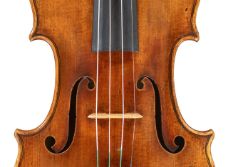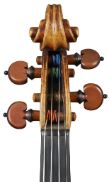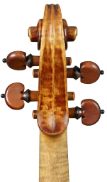Violin, Antonio Stradivari, Cremona, 1694, “ex Benecke”
Original printed label: “Antonius Stradiuarius, Cremonensis / Faciebat Anno 1694” (94 handwritten)Stradivari’s long career is classified into several periods that are distinguished by his development of, or preference for, specific body models. In this case, “model” denotes the size of the body, the proportion of the three body sections, and the shape of the arching. Until about 1690, Stradivari experimented with different models, with much of his work displaying features of Nicolò Amati’s instruments. Accordingly, instruments from this early period are frequently referred to as “Amatisé.” After 1690, Stradivari developed a new model that initiated the next period. The bodies of instruments built during this period are several millimeters longer; the arching is flatter. Evidently, Stradivari wished to add a deeper timbre especially to the two lower strings by lengthening the body. These elongated, slender-looking instruments, which include the “ex Benecke” violin from 1694, are built on what is now referred to as the long pattern. The collection of the Museo del Violino in Cremona includes a large number of Stradivari’s workshop utensils, also comprising many inner molds the master used to make his instruments. One of these forms, which is lettered “B” (inventory no. MS 33), is dated June 3, 1692. The proportions of the inner mold match the contours of the rib garland of the “ex Benecke” Stradivari, so it is quite possible that the instrument was built on this form.
The wood of the divided belly of this violin is very fine-grained in the middle, with the annual rings becoming wider toward the edges; their average width is just 0.64 mm. The most recent annual ring of the belly was dated 1683, and a dendrochronological analysis established that Stradivari used wood from the same log for other instruments built during the same period. The two-piece back is of quarter-cut maple displaying close, intense flames that descend marginally from the center to the edge. The rib and head wood has a very similar structure. The belly and back are less highly arched than those of the Amatisé model instruments. At this time, Stradivari had reached the pinnacle of his skill. The purfling and edgework bears witness to his superior craftsmanship. The f-holes are also perfectly proportioned and cleanly cut. The same can be said of the pegbox and scroll, whose edges were originally outlined in dark varnish. This instrument is exceptionally well preserved, which also holds true of the intense, reddish-brown varnish.
The violin has its name from the Benecke family, which owned the violin for five decades. Levin Anton Wilhelm Benecke was born in Hannover, Germany, in 1776. He had music lessons from an early age, but ultimately became a businessman and jurist. When Napoleon’s troops occupied Hamburg, he fled to England in 1813. He once again established a company with the support of other emigrants, and was highly successful. Next to his professional activities, he set great store by music performances in a home setting and provided his children with a good music education. His son Friedrich Wilhelm (1802–1865) continued this tradition – his circle of friends included the likes of Felix Mendelssohn Bartholdy and Joseph Joachim, who frequently visited the Benecke home and made music there. In 1862, Benecke purchased the Stradivari violin from Arthur Betts in London. At the time, the violin together with the bow and the case cost GBP 135. The violin remained in the family after Friedrich Wilhelm’s death. Arthur Hill, the top expert for Stradivari instruments in his day, described the violin in his diary in 1894 as “probably the finest of the long pattern that we know of.” Hill finally succeeded in purchasing the violin in 1914 and described it in detail in his standard work on Stradivari.
Borrower: Dalibor Karvay












